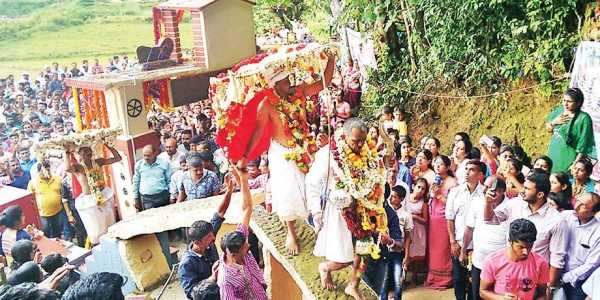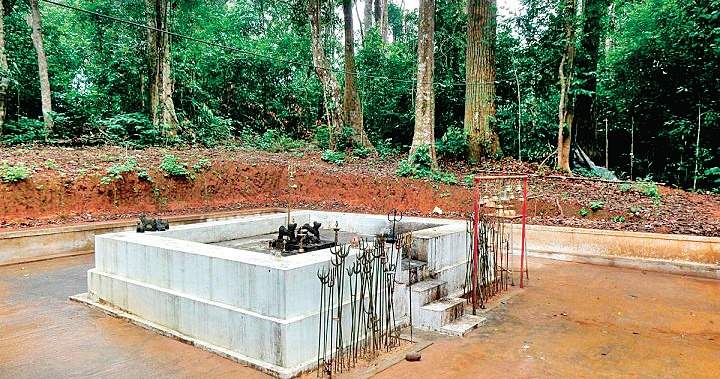Devara Kadu, or sacred groves, are a binding force between families and different communities of Kodagu district. Of late, encroachments are depleting this forest cover

Mangaluru :
Rumbustious, uncut, proud, magnificent trees; a plinth on which idols of folk deities sit alongside miniature terracotta sculptures of cattle, a harmless silence taken over by tweets of birds and insects – welcome to Devara Kadu temples situated amidst thick, unkempt forests of Kodagu. Ecological havens in every village of the district, Devara Kadu or the sacred groves are a binding force between families and different communities of the district.
The Malnad region is dotted with such sacred grooves. While Devara Kadu fall under the protected forests, they are treated as sacrosanct by the people resulting in the prohibition of felling, lopping or clearing of trees and even weeds. Light, water, air, earth, wind – the five elements — are glorified at these abodes of nature and paganism (nature worship) is revered and celebrated once a year at these groves.
‘Kadu Aiyappa’ is one of the ancient deities worshiped at Devara Kadu. “He (Kadu Aiyappa) chose solitude and a simplistic life in the wild, which is why he is till date worshiped amidst the virgin forests,” explains historian Bacharaniyanda Appanna.

Bhadrakali, Bhagavathi, Naga, Aiyappa, Eshwara, Ajappa are the common deities worshipped in Devara Kadu and each deity has a folk story connecting them closely to the villagers. The folk deities are revered as protectors and guardians of villages they are nestled at. “The place of Hathur, which is on Gonikoppal-Mysuru highway, has been a witness to many accidents. But these accidents have not killed a single person as Goddess Vana Bhadrakali of Hathur Devara Kadu, has protected them all,” says Kokkanda Belliappa, a villager of Hathur who like others here believes in the power of the Goddess.
Currently, there are nearly 1,214 Devara Kadu in Kodagu covering an area of 4,614 hectares and, 18 native communities are involved in worshiping 165 folk deities. “There have been a lot of encroachments. The deities are not as feared as before leading to these encroachments. However, the forest department is vigilant towards these offenders and we have taken several measures against such encroaches,” explains DFO Manjunath.
Nevertheless, in the past decade, Devara Kadu have been reduced to less than 9,000 acres from the original 15,000 acres, according to a survey on Devara Kadu.The ‘Devara Kadu Habba’ or the sacred grove festival, which takes place mostly between April and July (some annually and others biannually), is helping preserve the groves. “The ‘Eeroli Bana’ at Thaaka village of Cherambane is a Devara Kadu of Lord Aiyappa and is spread over 800 acres. It is believed that Kadu Aiyappa Swamy had stayed at this grove for two days. The grove is highly revered by the villagers and the fear of god is still existent, which has prevented encroachments. During the annual Devara Kadu festival, the villagers take a holy dip at the stream flowing in the grove. Entry to this grove is banned otherwise. A team of medical students had visited the grove in 1982 to conduct some research, but they could not proceed into the grove after a certain point,” says Appanna, a villager.
During the Devara Kadu festivals, the virgin groves echo with the praise of the deities. The spirit dance, sacrifices, ex-voto offerings (an offering given in order to fulfil a vow), grandeur god dance are just a few highlights. Prema, a resident of Hathur village, enters the Devara Kadu of Vana Bhadrakali with a trident. She explains, “I am offering the trident to the goddess as a thanks-giving for granting my wishes. People offer cattle to the goddess too.” The spirits of the folk deities are invited into the human body and these spirits listen to the problems of the villagers and provide solutions. The spirits also offer guidance to the village heads to help lead the village towards betterment, the villagers believe.
Even though Kodagu has one sacred grove for every 300 acres, the highest in the state, the groves are still depleting. The pressure of economic returns from plantations has resulted in their depletion. Yet, to some extent, the spiritual connections with these ecological havens are keeping them alive.
History
Granting of sacrosanct status to forests dates back to the Indus Valley civilisation. In Kodagu, kings considered a stretch of forest sacred and cared for the folk deity who in return protected his land. Devara Kadu of Kodagu falls under the tropical evergreen forest belt
Beliefs
Felling, lopping, clearing of fallen branches, plucking of weeds, pruning or burning of trees is prohibited in Devara Kadus. It is believed that offenders will be punished with death by the folk deity. Spirit dance, sacrifice, ex-voto offerings are common practices followed during Devara Kadu festivals.
Depletion
In all, 15,000 acres of Devara Kadu have today reduced to less than 9,000 acres due to continuous encroachments reported in the past decade. Immigration and economic returns are seen as major causes for encroachments.
source: http://www.newindianexpress.com / The New Indian Express / Home> States> Karnataka / June 17th, 2018

